While technologies like cellular and satellite phones have revolutionized onboard communication, they are still just supplements to the good-ole marine-band VHF radio. VHF radios not only provide direct communication with search-and-rescue (SAR) agencies in the event of an emergency, but also enable other vessels in the area to hear a distress call and respond, potentially even faster than SAR agencies-thats something a cell or sat phone cannot do.

Handheld VHF radios offer many of the features provided by fixed VHFs, but their lower antenna height and reduced transmit power means they have a shorter range (about 3 to 5 miles versus 10 to 15 miles for a fixed-mount VHF, or farther if theres a masthead antenna). However, they have one big advantage over their mounted brethren: portability. Portability allows them to serve as the primary radio on smaller boats, as an emergency backup or secondary working unit to a fixed VHF, or even as a way to summon help during an unexpected swim.
Our last series of full tests of VHF handhelds was in 2009. In the April 2009 issue, we looked at budget-priced handhelds; in June 2009, we reviewed their high-end counterparts; and the December 2009 issue included a test update. In the end, our favorites were the Standard Horizon HX280S for sailors on a budget and the Standard Horizon HX850S for those who wanted all the bells and whistles like GPS and Digital Selective Calling (DSC). Like many of the VHFs in that test field, the HX850 has since been replaced by an improved model (HX851), and a completely new crop of handheld radios has hit the market.
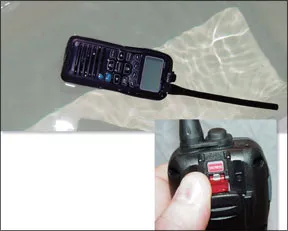
What We Tested
Testers evaluated seven radios from leading marine electronics makers, but the field of finalists was narrowed to six. Global communications-product manufacturer Icom supplied testers with two units, the M92D and M24. Marine electronics icon Standard Horizon submitted three: the HX290, HX300, and HX400. Widely known for its CB radios, wireless-communications leader Midland Radio provided its Nautico 2 for testing. Testers also evaluated the Midland Nautico 1, but because its antenna could not be removed, we could not run the same bench tests on it as we did the other VHFs; the Nautico 1 was also the only test radio not rated for water resistance, although it does have a dedicated dry bag. For these reasons, we decided to withdraw the very basic Nautico 1 from the test, but youll find testers notes on it below.
The units in our test group ranged in price and features from a $50 basic, budget-friendly model to a $299, feature-rich handheld. All shared a number of common features, including channel scanning, channel 16 quick select, NOAA weather radio, and weather alert. But there was also a laundry list of unique features among the group. These ranged from GPS and DSC operation to scrambler capabilities, remote microphone options, and the ability to float.
Our ideal VHF handheld has a large, easy-to-read screen, clearly marked keys, one-button control for key functions (volume, channel changing, etc.), and it is waterproof. Preferably, it floats and has an LED light for finding it in the dark. We also would choose one with DSC capability and GPS/navigating functions. This perfect VHF also would be affordable, have a sufficient warranty, and likely would have bonus features like the potential for a remote mic and an external antenna.
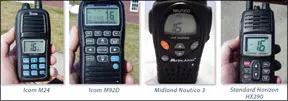
For our Buyers Checklist, guidance on selecting the VHF thats right for you, and a primer on common VHF features and functions, check out the online version of this article.
How We Tested
Testers charged up the radios and ran them through a series of bench tests, including transmitter power output, frequency accuracy and stability, and receiver sensitivity. All radios in our test group had good sound quality and met industry standards in the tests, but some did it better than others. Regulations set by the Federal Communications Commission (FCC) restrict the maximum power output of a handheld marine VHF transmitter to 5 watts and specify the need for a low-power setting, typically 1 watt, for harbor use. Testers took transmitter power measurements directly off the radio antenna ports. They also rated frequency accuracy and transmitter power stability at varying ambient temperatures. VHFs with less variation in frequency and power output rated the highest. To reach temperature extremes, testers placed each radio in a freezer (set at 8 degrees) for six hours. Frequency accuracy is defined as the ability of the transmitter to send out signals on a selected frequency. Frequency stability measures a transmitters ability to maintain frequency accuracy over its entire temperature operating range.
Receiver sensitivity is the ability of the radio to hear a weak signal. Marine VHF receiver sensitivity runs from 0.22 to 0.35 microvolts, with industry groups recommending a minimum of 0.50 microvolts. Each VHF was tested for the minimum signal it could receive at a specific industry standard between background noise and generated signal. All the radios we were able to test proved to be within industry standards. If you can’t hear the audio, it doesn’t really matter how well the transmitter or receiver works. To rate the audio systems, we measured sound levels while inputting a 1-kHz tone at maximum volume from 3 feet away. Testers also monitored a weather channel at various volume levels to determine overall sound quality.
Ratings for ergonomics indicate the ease of one-handed radio operation and include an allowance for size and weight. Testers rated displays on size and readability, quality of the information displayed, and the backlighting.
The five VHFs with a waterproof rating of IPX7 or greater (submersible to 3 feet or more) were submerged in fresh water for 30 minutes; buoyant radios were weighted. Rated only JIS4 (splashproof), the Nautico 2 (and Nautico 1, inside its dry bag) was exposed to a showerhead at a distance of 1 foot for 5 minutes. The effectiveness of locator LED lights or glow strips was also noted.
After the waterproof tests, we ran each radio through typical functions to verify they still worked. We also re-evaluated audio quality and inspected battery compartments for leaks.
To test battery longevity, testers exposed each unit to typical hourly operation requirements until the VHFs stopped functioning. To simulate industry standards, we keyed the test radios every hour for a total of 3 minutes and tuned to a weather channel broadcast at a moderate volume for 5 minutes. The Standard Horizon HX400 and Icom M24 outlasted the 16-hour battery life test. After 16 hours, testers set them to transmit a weather channel continuously and monitored how long their batteries lasted. (See Value Guide.) Charger styles and options were also evaluated for suitability in the marine environment and were considered in each radios overall rating.
All of the test radios come with three-year warranties.
Icom M92D
Icom’s M92D features noise-canceling, DSC, and GPS capabilities. The noise-canceling quiets background noise by up to 90 percent, according to Icom. The M92D was the only VHF in this test with DSC and GPS capability.
It has 14 buttons on the front panel and a DSC distress button on the back that is protected by a red, spring-loaded cover. The front buttons control things like scrolling, volume/squelch, menu select, enter, and power. The M92D also sports a rubber-capped jack input for an external speaker or microphone, and a full dot-matrix display shows selected soft key functions. The soft keys provide one-touch control of a number of functions, including selecting weather channels, backlight level, MOB function, waypoint list, compass page, and many more.
Testers found operation of the menu system to be straightforward and fairly intuitive. Although the display is large, crisp, and clear, its tasked with showing a lot of information (position, menu selections, etc.). As a result, the screen can be busy, and some of the text is small.
The M92Ds DSC functions include distress, individual, group, all ships, urgency, safety, and DSC test calls. Equipped with a 48-channel internal GPS and software features like a digital compass, waypoint database, and navigation functions, the M92D can also serve as a back-up navigation device, in a pinch. The M92D can store up to 100 DSC addresses and up to 50 waypoints, and it can navigate to them with just a couple button presses. The VHF can also mark and navigate to that all-important MOB waypoint, the only radio in our group able to do so. Although there is no dedicated MOB button, users can program a key to mark MOB position with one-touch entry.
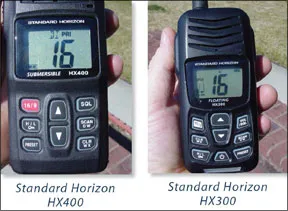
With any radio, water in the speaker and mic grills makes it difficult for others to understand you. The M92D allows users to quickly clear the speaker and mic of water using Icoms AquaQuake feature. Press two keys, and the radio emits a low-frequency sound blast designed to expel water from the grill. This feature worked well in tests and would be particularly useful in a man-overboard situation.
The M92D has an advertised battery life of eight to 10 hours, which it exceeded during our test. Its well-built charging cradle can be powered by a plug-in 120/240-volt wall unit or the included 12-volt cigarette lighter cable.
When dropped in water, the M92D floats in a face-up position. The entire keypad flashes, and it produces an audible beep as an aid for retrieval in the dark. Testers found the flashing keypad approach easier to spot than a single, flashing LED. The locator tone is a nice touch for help finding the VHF in a dark cabin or life raft, but with the speaker awash, it wasnt loud enough to be of much use.
The M92D package ships with the radio, rechargeable lithium-ion battery pack, charger tray, AC charger power cord, belt clip, DC charger power cord, wrist strap, screws to permanently mount the cradle, and an instruction manual.
Bottom line: Although its the most expensive unit in the test group ($299), the Icom M92D floats, has an internal GPS, provides navigational capabilities, and is DSC capable-what more could you ask a handheld radio to do? Its our top pick for sailors who want (and want to pay for) all the bells and whistles, or are seeking a handheld to use as their primary VHF.
Icom M24
The M24 is Icoms entry-level VHF handheld. It has nine front-panel keys that illuminate when pressed and provide access to all features. The M24 is internally regulated, meaning there is no charging cradle-you charge it by simply plugging the wall charger directly into the radio. This gives users one less component to worry about as there is no cradle and no exposed, corrosion-prone metal contact points to contend with. A watertight, screw-in cover protects the charging port on the radio.
One-button control is available for selecting transmit power, channel, weather channel, quick channel 16 or 9, all scanning options, and channel group. A designated pushbutton turns the radio on or off. Setting squelch and speaker volume requires users to select squelch or volume, then set the desired level using the arrow keys. To access and adjust other functions, users must drill down into the menu, which includes features such as power save, automatic backlight, weather alert, screen contrast, and additional channel scan options. Like the M92D, the M24 features AquaQuake.
Testers liked a number of things about this radio, the first being its size and weight. Icom claims the M24 has the smallest, lightest radio body in the world, based on its own 2010 market scan. With belt clip installed, the M24 weighed in at 8.6 ounces. The lightest floating unit in our test was the 8.4-ounce Standard Horizon HX300, but 0.2-ounce weight difference was not noticeable. Despite its light weight, the M24 has a solid heft to it. This, coupled with its ability to float, make it perfect for clipping onto a harness or PFD, or storing in an MOB fanny pack. (See Rambler 100 article in PS, May 2012.) The M24 floats face up, immersing its two contacts and activating a flashing red LED. This is Icoms Floatn flash feature, which makes it easier to locate the radio should it go overboard or get lost in a dark cabin or life raft. The LED kicks in even if the M24 is turned off at the time; this is true of all the VHFs we tested that were equipped with locating features.
The $144 M24 performed well overall and at 16 hours of runtime plus 10.5 hours receiving weather, it had the longest battery life of the group. It comes with a charger, belt clip, and hand lanyard.
Bottom line: The M24 gets a PS Recommendation for a mid-priced VHF handheld.
Standard Horizon HX290
The HX290 is Standard Horizons entry-level floating VHF handheld. Functions are controlled by eight front-mounted pushbuttons and an old-school twist knob to control power and audio volume. Theres also a top-mounted jack for an optional external speaker or microphone.
The HX290 provides one-button control for selecting transmitter power, channel, weather channel, 16/9 channel quick select, and some scanning options. Menu options include weather alert settings, screen backlight mode, and scan type. Scan modes include dual watch, programmable, or priority.
The HX290 has a few neat features: You can use the 16/9 quick-select button to go back to the last selected working channel; holding the squelch key lets you go to zero squelch (to aid in picking up a weak signal), and releasing the button returns it to the previous setting. A keypad lock disables all keys except the push-to-talk button, squelch, and the lock key. A transmitter timer limits continuous transmission to 5 minutes. Youll receive an audible warning a few seconds before the transmitter times out, and once that happens, the push-to-talk key is automatically disabled for 10 seconds.
The chassis is die-cast metal with a polycarbonate outer casing. The battery pack forms the back half of the radio, so replacing it will require buying the proprietary battery pack. The HX290 uses a drop-in cradle that will hold the radio or just the battery. Lights indicate charging status.
The HX290 was the only floating radio we tested that has a glow strip at the top of the radio, rather than a flashing LED or flashing keypad for locating. The HX290 floats face down, providing the best exposure for the luminous locating strip; however, testers found it to be far less effective than the flashing LEDs.
Performance-wise, the HX290 held its own. During our battery test, it lasted 14 hours, well past the 10 hours advertised. The HX290 does have an optional alkaline battery tray that holds six AA batteries, however the maker states that the radio will not float when using this option due to the additional weight of the batteries.
The display was bright and clear with easy-to-read numerals.
The HX290 comes with a charging cradle, AC and DC chargers, and a belt clip. It had no built-in lanyard loop attachment point in the body of the radio, but the belt clip has one, which means it has to be installed to use a wrist lanyard.
Bottom line: The HX290 is just what wed expect of an entry-level Standard Horizon radio. Performance, waterproof rating, and the ability to float make this our Budget Buy.
STANDARD HORIZON HX300
The Standard Horizon HX300 is a compact, lightweight unit that covers the basics and floats. Functions are controlled by nine front-mounted pushbuttons. Menu options include weather alert settings, screen backlight mode, audible beep, and scan type. Scan modes include programmable scan, priority scan, tri-watch, and dual-watch functions, and there are 10 channel presets.
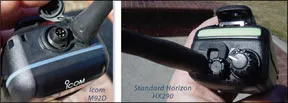
The HX300 shares many of the features we liked in the HX290, such as the ability to use the 16/9 quick select button to also go back to the last selected working channel. Holding the squelch key lets you go to zero squelch, and releasing the button returns it to the previous setting. It also has the keypad lock and the transmitter timer limit features.
The HX300 also has some features that set it apart from the HX290. First is the cell-phone-style battery, which provided a respectable 15 hours of runtime during our test. Another is the USB charging system, which allows the radio to be charged from a variety of sources (computers, solar chargers, car 12-volt outlets, etc.). If dropped overboard, the HX300 floats face-up and uses a flashing red LED strobe to help you find it. The LED is also programmable and can be made to flash SOS, for example.
Standard Horizons new intuitive menu system makes it easy to customize functions based on your preferences. The HX300 had a nice feel in the hand, and testers found the large display bright and easy to read.
The HX300 performed well, until the temperature test. After being removed from our test freezer, the unit powered up but shut down after a few seconds. It continued to do this for 8 to 10 minutes, when the unit warmed up.
The HX300 comes with a USB wall charger (100-240 volts AC, type-A plug) with a charging cable, a wrist strap, and a belt clip.
Bottom line: The HX300 is a radio with a lot to like, but we don’t recommend it for those in high latitudes or where the waters stay cold. Its performance in the temperature test held it back.
Standard Horizon HX400
The HX400 is billed as a fully submersible, commercial-grade marine VHF handheld with a built-in voice scrambler and Land Mobile Radio (LMR) band capabilities. Functions are controlled via eight front-panel pushbuttons and a rotary volume/power knob at the top of the radio, which also has a remote microphone/headset jack. One-button control is available for selecting transmitter power, channels, weather channel, preset channels, channel 16/9 quick select, and some scanning options.
Menu selections provide user control of beep volume, screen backlighting, scan settings, weather alert, channel names, noise canceling, and scrambler options. Scan modes include dual watch, tri-watch, programmable, or priority. Other features include a noise-canceling microphone, a keypad lock, and transmitter timer limit.
Users can also select up to 10 channel presets and can customize their menus. The HX400 was the only test radio with a built-in voice scrambler, which lets users hold a private conversation with another party that has a Standard Horizon radio equipped with a voice scrambler.
The HX400 is constructed on a die-cast metal chassis protected by a polycarbonate outer shell. At 12.3 ounces, it was the heaviest unit tested. The drop-in charger cradle comes with both 110-volt AC and 12-volt DC charge cables.
Like the HX290, the HX400 battery pack forms the back half of the radio. If you plan to cruise off the beaten track, we recommend taking a backup battery pack along since you wont be able to pick one up on the fly. Or you can use the optional alkaline battery tray with six AA batteries as an alternative power source.
Battery life was impressive. The HX400 has an advertised battery life of 17 hours. During our test, it lasted 16 hours transmitting and receiving weather plus 2.5 hours receiving weather only, the second longest in our test group.
The HX400 can be programed with up to 40 Land Mobile Radio (LMR) channels (137-174 MHz) with Continuous Tone-Coded Squelch (CTCSS) or DSC signaling, but it must be done by a Standard Horizon dealer. These channels require the appropriate FCC license.
The screen was bright, clear, and easy to read with large numerals. Onscreen icons indicate transmit power, channel preset, key lock, voice scrambler, priority channel, channel group, and battery-level indicator.
The HX400 was a solid performer, however after our submersion test, the audio was muffled and remained that way for roughly 30 minutes afterward. Shaking the handheld vigorously to dispel water from the speaker did not help. The HX400 package includes a three-hour rapid AC charger, DC charger cable, drop-in charge cradle, belt clip, and hand strap.
Bottom line: The HX400 is a solid radio with many desirable features. If you need LMR channels, the HX400 is the only unit in this test that fits the bill.
Midland Nautico
We reviewed the Nautico 1 and Nautico 3 from Midland, but as mentioned earlier, we dropped the Nautico 1 from the test field because its fixed antenna limited our ability to test it. Testers also noted that the Nautico 1 was held back by its small display, non-waterproof rating, and less than user-friendly operation.
Similar to the Nautico 1, the Nautico 3 is also a compact handheld, but it has a few upgrades its little brother lacks. Functions are controlled through five front-panel pushbuttons and a rotary volume/power knob. There is a remote speaker and mic/charging input with a weatherproof cover on the side.

The Nautico 3s features include auto squelch, keypad lock, channel scan mode, and NOAA weather alert radio with weather scan, and call alert tones. It also offers eVOX, an easy voice activation feature that provides hands-free operation, eliminating the need for an external microphone.
The display for the Nautico 3 is uncluttered and relatively easy to read, and while it is considerably larger than the Nautico 1s, its smaller than the rest of the test group. The frustrating functionality of the Nautico 1 lived on in the Nautico 3, but the unit is water resistant (rated JIS4, or able to withstand light rain or splashing water) and has a removable antenna.
The battery pack is a rechargeable, non-standard specialty item available only from Midland; there is an optional tray that uses four AA batteries. The Nautico 3 had the shortest battery life in the test.
Overall, the Nautico 3 was a good performer with good audio, frequency error, and receiver sensitivity. The Nautico 3 package we tested included the radio, a belt clip, one desktop holder with mounting hardware, a headset, a DC adapter, and one AC wall adapter.
Bottom line: The Nautico 3s operation is unnecessarily complicated, in our opinion, but if youre looking for an inexpensive backup, its worth considering. Just be sure to familiarize yourself with the operations.
Conclusion
All of the radios in our test group have sufficient audio quality and offer the primary benefits of a handheld VHF-redundancy (in the event your primary VHF fails due to dead batteries, fire, flooding, etc.) and portability-but some do it a lot better and include desirable features like buoyancy, a submersible rating, and a long battery life. DSC and GPS capabilities add value for emergency use. Price (as with most marine gear) is often the deciding factor between getting some or all of these features.
If you want a handheld that can do it all, the Icom M92D is the obvious Best Choice. If youre looking for a solid radio that delivers all of the basics for a more modest price, the Recommended Icom M24 deserves a look, as does our Budget Buy, the Standard Horizon HX290.
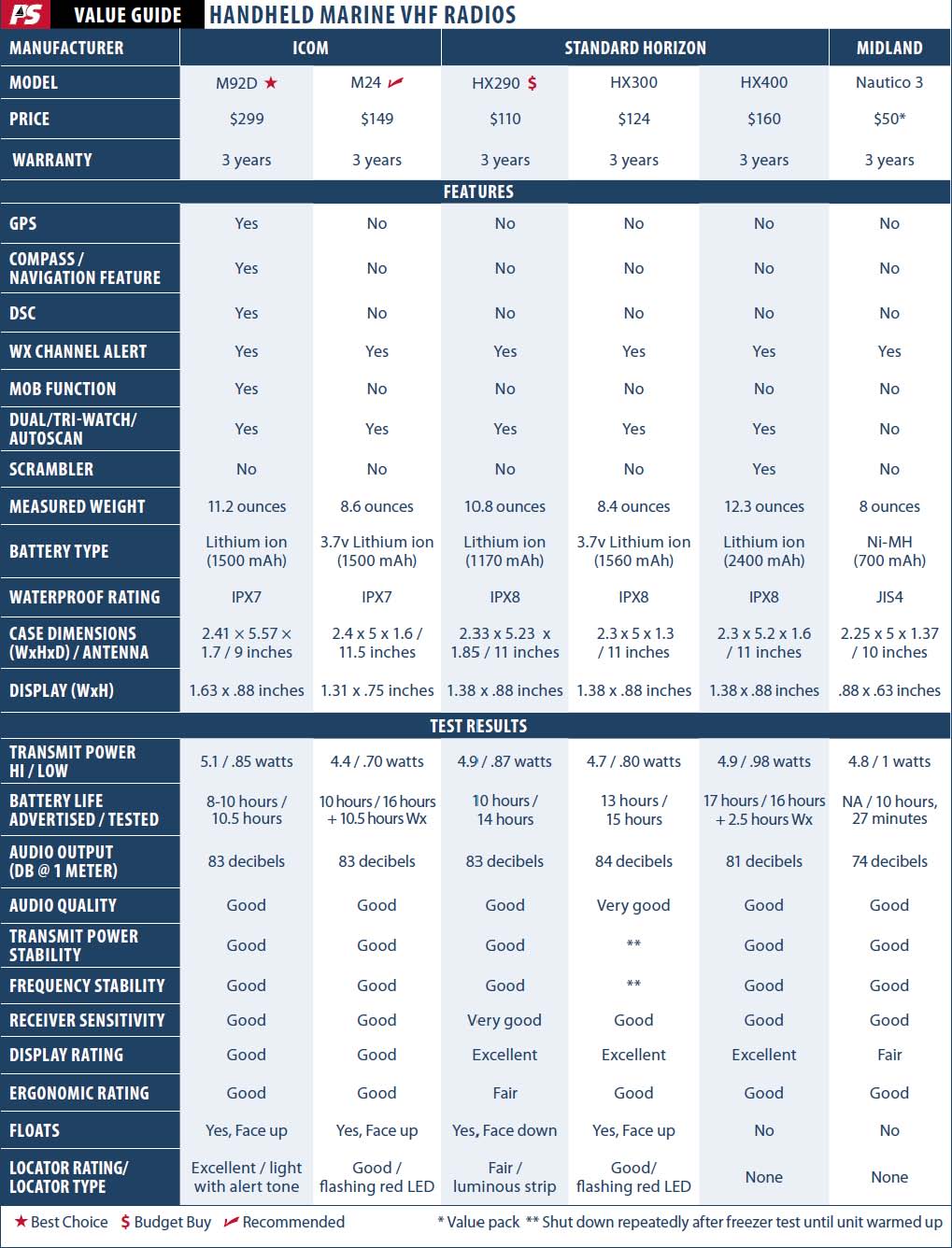


































only ever used a fixed mount, but thought a hand held in a grab bag sensible. yet you say only 3-5 nm reception? on that basis i will swop it for a can of beer and instead stand on deck waving a hanky- which shld also be good for 3 miles